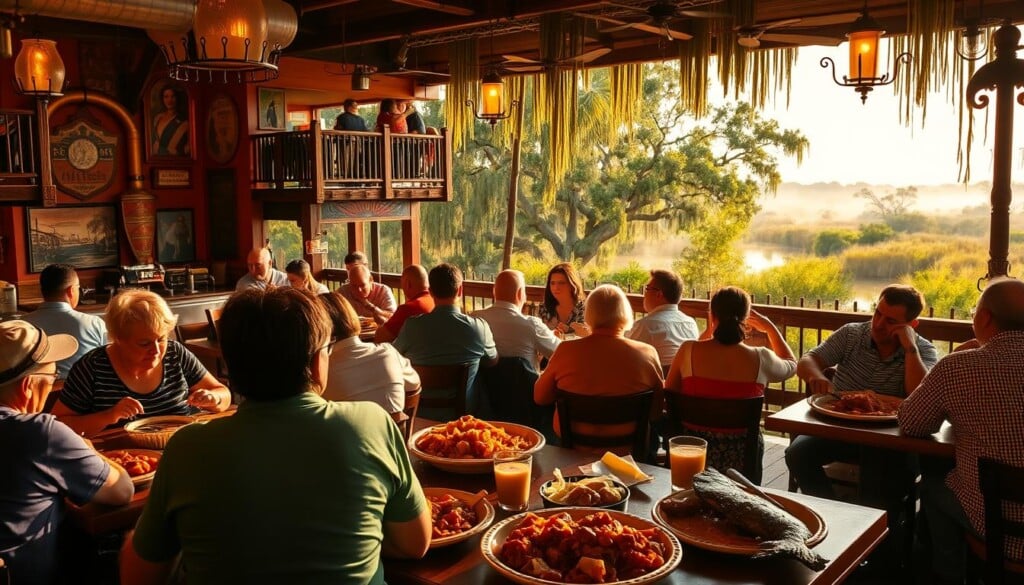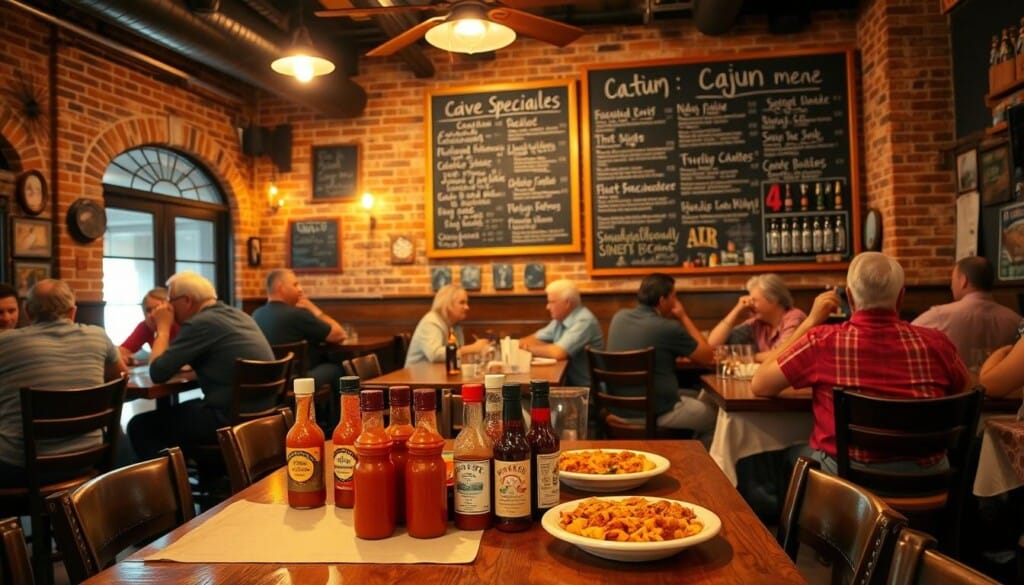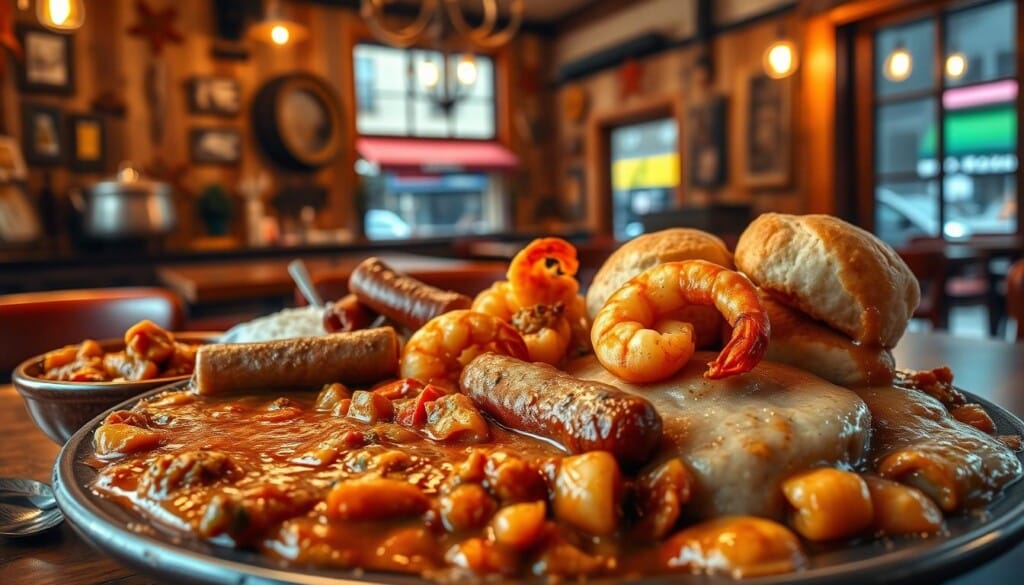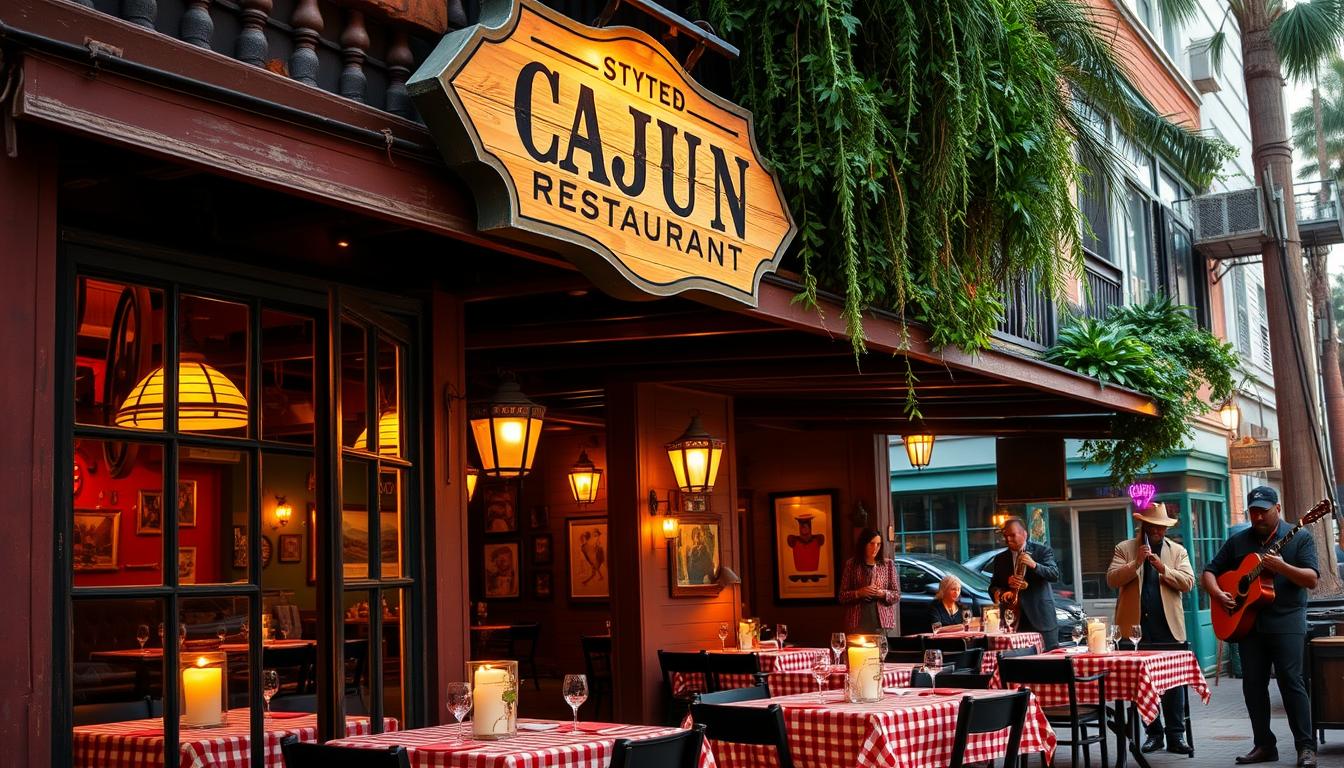Did you know the true heart of Cajun cuisine lies beyond Louisiana? This article takes you on a delicious journey to find the top Cajun restaurants across the US. You’ll learn about the rich flavors and traditions of Cajun cooking. Get ready to explore where to find the best Louisiana dining that brings Cajun culture to life.
Key Takeaways
- Uncover the best Cajun restaurants nationwide.
- Understand the roots of authentic Cajun cuisine.
- Discover regional favorites and unique culinary traditions.
- Experience the richness of spicy Creole dishes.
- Learn how to find genuine Louisiana dining experiences.
What is Cajun Cuisine?
Cajun cuisine is a vibrant tradition from Louisiana. It comes from the Acadian settlers from Canada. They brought their cooking to the south after Le Grand Derangement. This mix of French heritage and local ingredients created bold flavors.
Knowing where Cajun cuisine comes from helps us enjoy its rich dishes. It’s a mix of diverse and hearty foods.
Origins and History
The Cajun settlers came from L’Acadie in the 18th century. They used local ingredients to make their own recipes. This made a unique style different from Creole cuisine.
The heart of Cajun food is its strong flavors and simple cooking. It shows the community’s lifestyle and heritage.
Key Ingredients in Cajun Cooking
Onions, bell peppers, and celery are the “holy trinity” in Cajun cooking. They add depth to many dishes. Garlic, cayenne pepper, and smoked meats also add bold flavors.
These ingredients make Cajun food hearty and warm. They show the cuisine’s true spirit.
Popular Cajun Dishes
Cajun cuisine has many famous dishes. Gumbo is a savory stew with proteins and veggies. Jambalaya is a flavorful one-pot meal with rice, meats, and spices.
Etouffee is another favorite, with rich sauces and tender proteins. These dishes highlight the unique flavors and cultural importance of Cajun cuisine.
Top Cajun Restaurants by Region
Cajun cuisine is found all over the United States, with each region adding its own twist. This mix of local flavors and Cajun traditions offers a wide range of dining experiences. Here, we explore the best Cajun restaurants, from the East Coast to the South.
East Coast Favorites
East Coast Cajun restaurants are cultural hubs. Chefs blend local seafood and produce with Louisiana flavors. This creates dishes that are both new and true to Cajun roots, making for a unique dining experience.
Midwest Gems
In the Midwest, Cajun food gets a local twist. Restaurants use Midwestern ingredients but stick to traditional Cajun recipes. This blend brings authentic Cajun tastes to the heartland, combining comfort with authenticity.
Southern Staples
The South, and Louisiana in particular, is where Cajun food shines. Southern Cajun dishes are a staple, showing off a rich culinary heritage. These restaurants serve up classic dishes that celebrate the area’s history and culture.

Famous Cajun Dishes to Savor
Step into the world of Louisiana cuisine and discover famous Cajun dishes. These dishes are a testament to the region’s rich culinary heritage. Each dish has its own story, blending local ingredients and traditional techniques to create unforgettable flavors.
Gumbo: A Signature Dish
Gumbo is often seen as the quintessential Cajun dish. It’s a rich stew filled with meats, seafood, and vegetables. The heart of gumbo is its dark roux, which mixes perfectly with spices and local ingredients. Served over rice, it captures the essence of Louisiana cuisine.
Jambalaya: A Flavor Explosion
Jambalaya is a vibrant one-pot meal bursting with flavors. It combines rice, meats, and vegetables for a feast for the eyes and taste buds. With its diverse ingredients, jambalaya can be mild or spicy, showing the Cajun culinary versatility.
Po’ Boys: A Local Favorite
Po’ Boys are a beloved sandwich, served on crusty baguettes. They can be filled with fried seafood or roast beef. Trying a Po’ Boy is essential for anyone exploring Cajun dishes, as it captures Louisiana’s culinary spirit. Learn more about Cajun favorites through LocalZ.
How to Choose the Right Cajun Restaurant
Finding the right Cajun restaurant can be both exciting and tricky. There are so many choices out there. To get a true taste of Cajun culture, you need to look at a few key things. These include the authenticity of the food, what locals say, and the variety of dishes on the menu.
Looking at Authenticity
It’s important to check if the restaurant serves authentic Cajun food. Real Cajun places use old cooking ways and local ingredients. This shows they really care about Cajun culture.
Checking for Local Reviews
Reading what locals say is a big help. Reviews tell you about the food and service quality. If many people say good things, you’re likely to have a great time.
Menu Variety and Specialties
A good Cajun restaurant has a menu full of classic dishes. They should also have some new twists on old favorites. This mix means you might find something truly special.

Best Cajun Restaurants in New Orleans
New Orleans is a lively place for Cajun food, mixing flavors and traditions. Looking for the top Cajun spots in New Orleans? You’ll find legendary places that have shaped the local food scene for years. These iconic spots serve traditional dishes and celebrate the area’s rich heritage.
Iconic Spots Not to Miss
Cochon and Restaurant R’evolution stand out for their use of local ingredients and creative cooking. These places capture the heart of Cajun dining, making every visit unforgettable. Their unique atmosphere and dishes make them must-sees for everyone.
Newer Establishments Worth Trying
New Cajun places are also changing the dining scene. Lula Restaurant Distillery is a new favorite, known for its craft cocktails and authentic Cajun food. This mix of flavors and ideas adds to New Orleans’ diverse food scene.
Exploring Cajun Flavors Beyond Louisiana
Cajun cuisine has grown far beyond Louisiana, showing off its bold tastes and special cooking ways in many places. This growth shows how well Cajun dishes can adapt, bringing new life to old recipes.
Cajun Influence in Other States
Cities all over the U.S. have welcomed Cajun food, introducing it to new people. In Los Angeles, chefs mix local ingredients with Cajun spices, making new dishes that keep traditional tastes alive. Chicago also loves Cajun food, with chefs adding Midwestern touches to Louisiana’s rich flavors.
Creative Takes on Traditional Dishes
Chefs are making Cajun classics their own, mixing old ways with new ingredients and methods. This creates dishes that are both exciting and true to Cajun roots. You can try gumbo with Asian twists or jambalaya with local seafood, all while enjoying the heart of Cajun cooking.

How LocalZ Connects You with Cajun Restaurants
LocalZ makes finding great Cajun food easy. It’s an online guide that helps you find Cajun restaurants that match your taste. You can quickly find places that offer the Cajun dishes you love.
Search for Authentic Dining Experiences
LocalZ is perfect for those who want real Cajun flavors. You can search by specific criteria. This way, you’re sure to find places that serve true Cajun cuisine.
Personalize Your Restaurant Search
LocalZ lets you tailor your search. You can filter by dish type or atmosphere. This helps you find places that fit your taste and mood for Cajun food.
Filter by Reviews and Recommendations
LocalZ uses community feedback to guide you. You can see what others say about a place. This helps you choose restaurants known for quality and authenticity.
Supporting Local Communities through Dining
LocalZ helps local economies grow by encouraging people to eat at nearby places. It connects food lovers with small restaurants, helping them succeed. This effort makes local food scenes lively and diverse.
Impact of LocalZ on Neighborhoods
LocalZ is all about helping local businesses grow. It shows off different places to eat, helping local spots get more customers. This not only helps the economy but also makes people feel more connected to their community.
It focuses on community cafes and bistros, keeping each area’s unique flavor alive. This makes local pride strong and keeps areas special.
Engaging with Community Affiliates
LocalZ also gives back to the community. It shares half of its annual Business Listing Fee with local groups. This helps local events and brings people together.
By doing this, LocalZ makes neighborhoods more lively and supports local restaurants. It makes dining a better experience for everyone.
Planning Your Visit to a Cajun Restaurant
Visiting Cajun restaurants is a fun food adventure. But, planning well is key for a great time. This section gives tips to make your visit memorable and enjoyable.
Making Reservations
Many Cajun restaurants are popular, so booking ahead is smart. Places like New Orleans get very busy, even more so during peak times. Reserving a table means you won’t wait and can enjoy the Cajun food more.
Understanding Menu Specialties
Knowing the menu before you go is a big plus. Cajun restaurants have many dishes using local ingredients and traditional ways of cooking. This helps you choose the best dishes and enjoy the unique Cajun tastes.
Tips for First-Timers
If it’s your first time at a Cajun restaurant, be ready for bold flavors. Ask the staff about their favorite dishes and get their advice. Talking to the servers can also help you find special menu items you might not have tried.
Why Cajun Cuisine is a Must-Try
Cajun cuisine is a must-try for anyone wanting to dive into Southern cooking’s rich flavors. It’s known for its unique tastes, blending African, Native American, and French influences. This mix creates dishes that excite your taste buds and tell stories of the region’s diverse culture.
The roots of Cajun cuisine are deeply tied to Southern culture, highlighting Louisiana’s agricultural wealth. It shows the heart of Southern living, giving diners a peek into the area’s history and traditions. Trying Cajun dishes is like exploring Louisiana’s vibrant culinary heritage.
As Cajun cuisine gains popularity in the U.S., more restaurants are opening. This lets more people enjoy its authentic flavors. The growing interest in these tastes helps celebrate Southern culture. By trying these dishes, diners help keep this unique culinary tradition alive.

